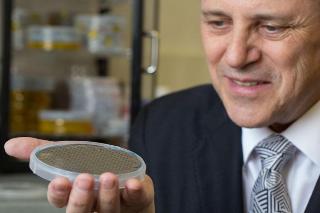Jun 19 2015
A George Washington University professor has designed new technology that can identify traces of chemicals at 10-19 moles, a previously undetectable amount. This minute quantity can be conceptualized as 10 times below a billionth of a billionth of a teaspoon of water.
 Dr. Vertes holds a silicon wafer containing multiple the REDIchip devices, a new device that can detect ultratrace amounts of chemicals. Credit: The George Washington University
Dr. Vertes holds a silicon wafer containing multiple the REDIchip devices, a new device that can detect ultratrace amounts of chemicals. Credit: The George Washington University
Akos Vertes, professor of chemistry in the GW Columbian College of Arts and Sciences, invented the technology behind the REDIchip (Resonance-Enhanced Desorption Ionization) as part of a project aimed at reducing the amount of time needed to identify biological and chemical matter.
While the project was conceived to help identify potential chemical and biological threats, the technology has the ability to assist in multiple fields. The REDIchip can detect drugs in urinalyses, provide earlier detection of emerging health problems, enhance medical imaging, improve tumor margin determinations and identify endocrine disruptors in the environment.
"The extraordinary capability of the REDIchip will easily impact the security, health and environmental sectors, critical drivers of today's economy," said Michael King, chair of the GW Department of Chemistry. "This invention is translational science at its best. It has been exciting to watch the ideas flow from the early stages of the doctoral students in Dr. Vertes' research group to a patented invention to a commercialized product."
"Because of the extreme sensitivity of the REDIchip, harmful chemical changes can be detected early on, while the chances of mitigation are greater. Alternatively, sample sizes as small as a single yeast cell are sufficient for detailed analysis," said Dr. Vertes. "The REDIchip platform has potential applications in drug discovery; the analysis of tissues, cells and biofluids; discovery of natural products; and the identification of previously undetected environmental contaminants. Imaging of molecular distributions in biological tissues by the REDIchip technology can reveal if a drug candidate localizes to the targeted organ."
The REDIchip, commercialized by Protea, will be available for purchase beginning next month. The technology was invented and commercialized with funding provided by the
U.S. Department of Energy and the Defense Advanced Research Projects Agency (DARPA), respectively. Part of this research (fundamental studies) was supported by the Department of Energy, Office of Science, Office of Basic Energy Sciences, Chemical Sciences, Geosciences, and Biosciences Division under Award # DE-FG02-01ER15129. Other parts of the research (commercialization) were sponsored by the U.S. Army Research Office and DARPA and were accomplished under Cooperative Agreement Number W911NF-14-2-0020. The views and conclusions contained in this document are those of the authors and should not be interpreted as representing the official policies, either expressed or implied, of the Army Research Office, DARPA, or the U.S. Government. The U.S. Government is authorized to reproduce and distribute reprints for Government purposes notwithstanding any copyright notation hereon.